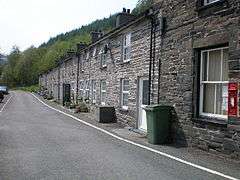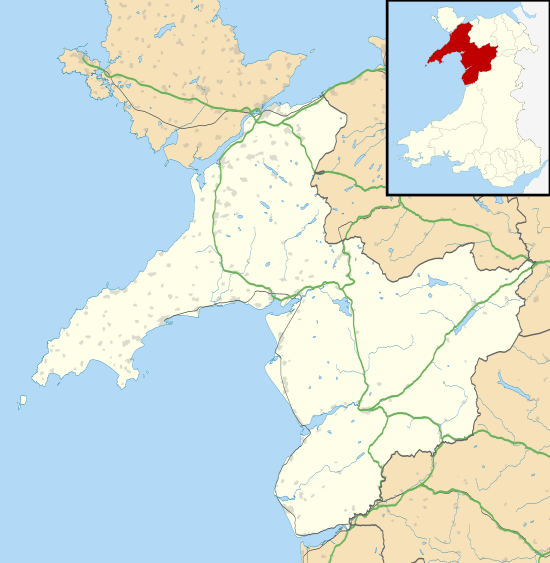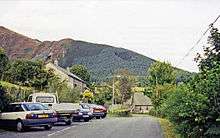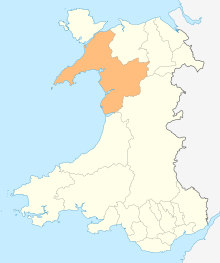Aberllefenni
Aberllefenni is a village in the south of Gwynedd, Wales. It lies in the historic county of Merionethshire/Sir Feirionnydd, in the valley of the Afon Dulas, and in the community of Corris.
| Aberllefenni | |
|---|---|
 Pensarn Terrace | |
 Aberllefenni Location within Gwynedd | |
| OS grid reference | SH770097 |
| Community | |
| Principal area |
|
| Ceremonial county |
|
| Country | Wales |
| Sovereign state | United Kingdom |
| Post town | MACHYNLLETH |
| Postcode district | SY20 |
| Dialling code | 01654 |
| Police | North Wales |
| Fire | North Wales |
| Ambulance | Welsh |
| UK Parliament | |
| Senedd Cymru – Welsh Parliament |
|
It is the location of Foel Grochan, a slate quarry which together with Hen Chwarel and Ceunant Ddu formed the Aberllefenni quarry, which extracted rock from mediaeval times until the beginning of the 21st Century.[1] The quarry waste tips appear in the No Quarter: Jimmy Page and Robert Plant Unledded video when Jimmy Page and Robert Plant, formerly of Led Zeppelin, performed there with their band in August 1994.
The less successful Cambergi and Hengae quarries lay about 0.5 miles (0.80 km) west of Aberllefenni, while the Cymerau and Ratgoed quarries lay to the north, connected to the Corris Railway at the village by the Ratgoed Tramway.
The Roman road between northern and southern Roman Wales, Sarn Helen, probably ran through the village; the terrace of houses known as Pensarn (head of the causeway) may be a reference to it. Sarn Helen ran north-west from the village along Cwm Hengae towards Dolgellau.[2]
The village is the site of a field study site for secondary school pupils.
History
Plas Aberllefenni (also known as "Y Plas") was a mediaeval manor house, but the older section was demolished in the 1960s and only a later wing is still standing.
The quarry reservoir, Llyn Cob, was once known as Llyn Owain Lawgoch, after the last male survivor of the princely house of the Kingdom of Gwynedd.
Just north of the village once stood Pont Cymerau, one of the ancient bridges of Wales, which crossed the Afon Dulas just upstream of where it is joined by the Nant Ceiswyn.[3]
The Aberllefenni Brass Band was active from the mid-1880s until the outbreak of the First World War.[4]
Corris Railway

Aberllefenni railway station was a station on the former Corris Railway, a narrow gauge railway which ran from Aberllefenni to Machynlleth. The station was open from 25 August 1887,[5] until the end of passenger services, in December 1930.[6]:7 It was the northern terminus of passenger services for the entire of this time, and the northern limit for steam locomotive working from 25 August 1887 until the railway's closure on 20 August 1948. The track was lifted between Aberllefenni and Corris in November 1948.
The site of the former station was used for the construction of council houses in the 1960s, apart from the passing loop, which was used to provide parking spaces on the road. The road serving these council houses was named Maes-yr-Orsaf (English: Station Field), in memory of the station.[6]:25–26
Two horse-worked tramways extended the railway beyond Aberllefenni Station:
- the Aberllefenni quarry tramway connecting the slate mill in the village with the three quarries
- the Ratgoed Tramway serving Cymerau quarry and Ratgoed quarry[1]
| Preceding station | Disused railways | Following station | ||
|---|---|---|---|---|
| Garneddwen | Corris Railway | Terminus |
In Fiction
Aberllefenni Station was used as the basis for Glennock on the fictional Skarloey Railway and can be seen illustrated in the book Four Little Engines.
References
- Alun John Richards (2004). Slate Quarrying at Corris. Llygad Gwalch Cyf. ISBN 978-1-84524-068-4.
- An Inventory of the Ancient Monuments in Wales and Monmouthshire: VI - County of Merioneth. Royal Commission on the Ancient and Historical Monuments of Wales. 30 December 1921. pp. 164–. GGKEY:U89CDD2G7U4.
- Edwyn Jervoise; Society for the Protection of Ancient Buildings (London, England) (1936). The ancient bridges of Wales and western England. The Architectural press.
- Gavin Holman. Brass Bands of the British Isles 1800-2018 - a historical directory. Gavin Holman. pp. 16–. GGKEY:GQ33ZH6H71E.
- Boyd, James I.C. (1965). Narrow Gauge Railways in Mid Wales. The Oakwood Press. pp. 24–25.
- The Corris Railway Society (2009). "The Corris Railway – 1859 to 1948". Corris Railway – Guidebook & Stocklist. Template Printing (Nottingham) Limited.
| Wikimedia Commons has media related to Aberllefenni. |
